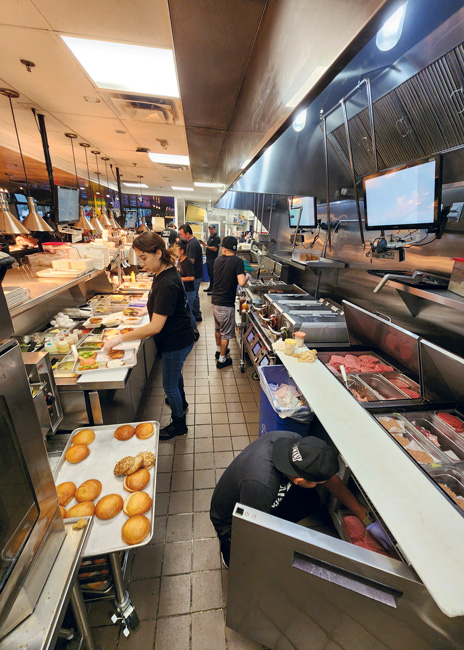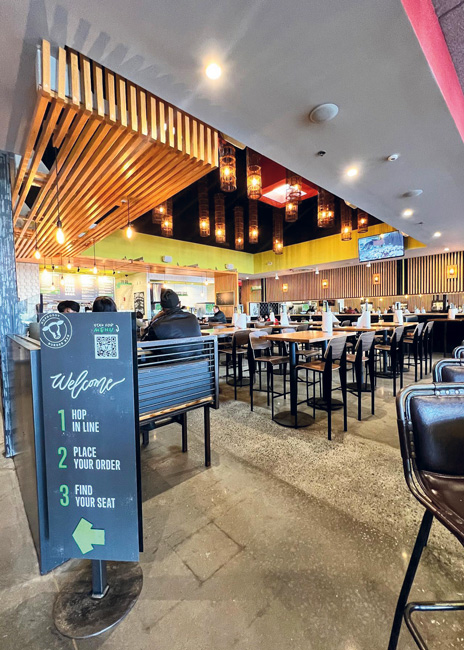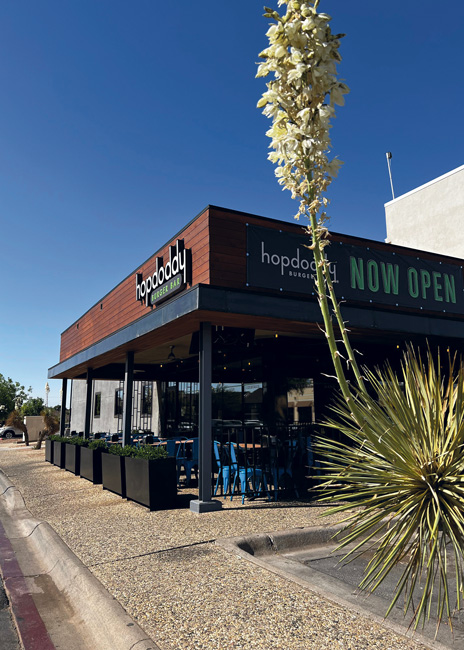This craft burger chain reworked its kitchen operations and information flow to dramatically improve ticket times.
 Plenty of chains would be happy to have Hopdoddy Burger Bar’s problems.
Plenty of chains would be happy to have Hopdoddy Burger Bar’s problems.
Since its founding in 2010, this craft burger chain based in Austin, Texas, has grown to nearly 50 restaurants in 8 states — all company-owned. The chain has been so successful with customers, in fact, that it hasn’t had trouble attracting guests. The problem has been keeping up with demand.
“We were never challenged for sales. We were challenged with being able to serve enough people in a condensed amount of time,” says Matt Schweitzer, the company’s chief revenue officer. “A lot of our business comes in at once, especially with the rise of online ordering. We were one of the blessed concepts that didn’t have sales issues. We had throughput issues.”
These issues got so bad at times, Schweitzer says, that restaurants would simply stop taking orders. They’d turn off online ordering and even tell guests at the register to wait until the kitchen could catch up. It was clear something had to change.
The Hopdoddy Experience
Struggling to meet demand is, of course, a sign of success. And Hopdoddy’s food serves as a major driver of its success. While there are plenty of elevated burger concepts, Hopdoddy stands out for its unique burger builds along with the sheer number of proteins it offers.
 The elevated burger experience at Hopdoddy translates in part to a large array of protein options.Among these are several types of beef patties, including grass-fed options and patties of different sizes. The menu also has a bison burger, a ground chicken burger, a black bean and corn burger, and an ahi burger.
The elevated burger experience at Hopdoddy translates in part to a large array of protein options.Among these are several types of beef patties, including grass-fed options and patties of different sizes. The menu also has a bison burger, a ground chicken burger, a black bean and corn burger, and an ahi burger.
Toppings on these chef-curated offerings can get especially creative. They include teriyaki, nori chips, pickled ginger, lettuce, tomato and cucumber wasabi on the Ahi Tuna burger; pepper jack cheese, roasted habanero and serrano peppers, caramelized onions, salsa roja, lettuce, tomato and chipotle aioli sauce on the El Diablo burger; and creamy goat cheese, field mushrooms, lettuce, tomato, onion, mayo and basil pesto sauce on the Magic Shroom burger.
Guests can pair these sandwiches with french fries or fried Brussels sprouts. All can be washed down with a craft beer or specialty cocktail from the full bar, which offers everything from margaritas to mules.
The Hopdoddy experience, too, brings guests in the door. The chain’s service model is something of a hybrid. Customers place their orders at the POS station, but from there, it’s full service, with table runners delivering food and drinks and bussing tables. This all happens in an environment that Schweitzer describes as grungy but not grimy — and very Austin. “It’s relaxed,” he says. “There are band posters on the wall, pictures of local music artists on the wall. We’ve got comfortable booths, a full bar and a few TVs.”
Third-Party Problems
Not every guest eats their Hopdoddy meal at Hopdoddy. The chain’s strong digital sales come in via multiple channels, including its website and third-party delivery apps. These sales, Schweitzer says, drove many of Hopdoddy’s throughput problems. “In a previous life, when your restaurant was full, you were full. You couldn’t do any more business. But with the explosion of online ordering, your restaurant can be full, you can have a line out the door, and you have an unfettered, unregulated sales funnel with third-party and online ordering piping directly into the kitchen. That causes a lot of slowdowns.”
In recent years, Hopdoddy took some steps to improve its throughput. The biggest was moving from a flattop grill to a clamshell with three platens. While this change was meant to speed up production, it simply wasn’t paying off. In fact, with the lack of flexibility of a clamshell compared with a griddle, the problem would often get worse when demand was highest.
To help address the clamshell problem, and Hopdoddy’s throughput issues in general, the chain brought on Profitality Labor Guru, an industrial engineering-based consulting group based out of Miami, to develop a new kitchen line design.
Info Flow
Juan Martinez, Profitality principal and co-founder, led his firm’s work with Hopdoddy. After studying the chain’s kitchen design and operations, he found the biggest challenge wasn’t equipment. It wasn’t even the flow of work. Instead, it was the flow of information. The chain, Martinez says, wasn’t getting “the right information to the right place at the right time.”
The first and biggest choke point was the clamshell grill station and its kitchen display system (KDS) screen. “When they sent information to the grill, that same information went just about everywhere,” says Martinez. In the case of the grill, the information included not just the protein to be cooked, but everything else on the sandwich, including the cheese, sauces and other toppings.
 Hopdoddy locations feature a full bar and natural finishes.Each order would take up so much space on the screen that the line cook could only see about 10 burgers at a time, even if there were dozens in the system. This prevented the cook from adding more burgers as needed and using the clamshell efficiently.
Hopdoddy locations feature a full bar and natural finishes.Each order would take up so much space on the screen that the line cook could only see about 10 burgers at a time, even if there were dozens in the system. This prevented the cook from adding more burgers as needed and using the clamshell efficiently.
What’s more, even after a burger was cooked and sent to assembly, it would stay on the grill’s KDS screen until someone at another station completed their work and bumped it off. This process, Martinez says, contributed to production times that were three to four times as long as they should be. A burger that should take just 5 minutes to produce often took 15 to 20 minutes.
Profitality and Hopdoddy, then, worked together to redesign the kitchen’s information flow. This was a trial-and-error process, Martinez states. Often, solving a bottleneck at one station would cause or reveal a bottleneck at another. After working through different approaches, the chain finally has an information flow and line design that works from the grill to expo.
Stations now get only the information staff working there needs to complete their tasks and can bump orders off their screen when their part of the job is complete. Information is fed to KDS screens and ticket printers in a coordinated manner so, ideally, each job is done “just in time” without any item sitting for too long.
This redesigned information flow has not only sped up service, it has also improved food quality. One example: The tasks sent to the grill station and the assembly station previously were not coordinated. As a result, buns with condiments and produce would sometimes sit for several minutes waiting for their proteins. Now, buns, toppings and proteins are ready at roughly the same time, allowing orders to be sent to guests as freshly cooked as possible.
While Schweitzer says he expected faster production, this type of improvement was a surprise. “I had no idea that Profitality was going to show me my food could be better when I cook it faster, which is a complete paradigm shift,” he says. “The quality of my food improved, even though I already thought it was world-class, because of these efficiency and throughput improvements.”
Workflow Reworked
Information flow isn’t the only thing that changed in Hopdoddy’s kitchen. With this redesign, the chain also adjusted its equipment package, kitchen design and the workflow.
These changes start from the very first spot on the hot line, at the chicken breading station. The station includes an undercounter refrigerator for raw chicken, with a breading station on top, as well as a new holder for pre-breaded chicken. To maintain food quality, this holder only stores a few orders of tenders and breasts at a time. Nevertheless, it shaves precious seconds off cook times for these items.
 Hoppdoddy has improved its systems and solved throughput issues.Also speeding up chicken orders is the ability to cook and store these items for a very short amount of time. During peak periods, when line cooks know chicken orders are coming, they have one or two orders of tenders and chicken breasts cooked and ready to serve. Hopdoddy keeps these items in a small hot-holding unit on the assembly line, just a 180-degree turn from the breading/fry station.
Hoppdoddy has improved its systems and solved throughput issues.Also speeding up chicken orders is the ability to cook and store these items for a very short amount of time. During peak periods, when line cooks know chicken orders are coming, they have one or two orders of tenders and chicken breasts cooked and ready to serve. Hopdoddy keeps these items in a small hot-holding unit on the assembly line, just a 180-degree turn from the breading/fry station.
“When it gets busy, you know they won’t be there for too long. If you see on the screen that those are about to be sold, you drop another one, following a ‘just-in-time’ methodology,” Martinez says.
Past the breading station sits a bank of four fryers for the chicken, french fries and Brussels sprouts. Since Hopdoddy cuts its fries in-house from whole potatoes, there’s no need for a dedicated fry freezer near the hot line. Instead, the chain holds raw potatoes on a rack on the assembly line, near the chicken hot-holding unit.
Next on the hot line is a small flattop grill. While the chain replaced its large flattop with a clamshell, it added this new unit to add the cheese and hot sauces for different sandwiches. Since the clamshell is significantly smaller than the large flattop grill it replaced, there was space under the hood for this small grill, reducing the cost to convert a kitchen line.
The new, smaller flattop is key to speeding up ticket times, says Martinez. Pre-redesign, proteins would remain on the clamshell while staffers melted cheese and added sauces. This contributed to Hopdoddy’s production problems. Now, staff move cooked patties from the clamshell to the grill for cheesing/saucing.
In addition, culinary staff use the new flattop to cook the chain’s ahi. On the clamshell, the tuna would cook in less than a minute, which was much faster than the other proteins. On the grill, it takes around two minutes. This brings it in line with beef and other proteins cooked on the clamshell, which makes coordinating group orders a bit easier.
The clamshell comes next on the hot line, followed by a cold table. Wells on top of the cold table safely hold raw proteins, with backups stored below for quick restocking.
The cold assembly line also got reworked in this redesign.
One major change involves bun handling. Since the chain receives its buns parbaked and finishes baking them in-house, it also handles slicing on the premises. That was previously done on the assembly line.
According to Martinez, slicing the buns “was moved to prep in order to free up space for actual assembly. The extra space was necessary because of the higher throughput of the clamshell.”
The assembly line, then, centers on a bun toaster, which sits in the middle of the line, with sliced buns held beneath.
Cold tables sit on both sides of the bun toaster. These hold condiments, sauces and toppings like lettuce and tomatoes. During slower periods, the staff use only one table, while both get put to work during peak demand. On one side, there’s also space for sauces and cheese destined for the patties on the small flattop.
At one point, the design called for the cheese to be held on the hot line near the grill, but that was scrapped because high temperatures would have melted the cheese. Refrigerated drawers could have been added below the grill, Martinez notes, but that would have added to the costs of retrofitting legacy stores with the new kitchen.
Retrofit Plans
The task of bringing existing restaurants up to date is underway. Since cost is a concern, not every equipment change is required. Based on volume, some restaurants may not need to move their bun toasters to the middle of the assembly line, for instance.
But some elements are essential, Martinez says. The small grill for cheese melting/saucing/ahi cooking is required, as is the reworked flow of information to the different KDS screens and ticket printers throughout the kitchen.
No matter what’s done in these retrofits, though, more changes to Hopdoddy’s operations are coming. Schweitzer has future projects in the works with Profitality, including efforts to stabilize or even reduce labor costs through predictive metrics.
Still, the impact of the redesigned flow of work and information in Hopdoddy’s kitchen alone has been enough to “transform the future” of the concept, Schweitzer says. While Hopdoddy once had to turn away business and turn off sales channels, it can now take all those orders without risking massive wait times and bad customer service.
At a Glance
- Chain headquarters: Austin, Texas
- Year founded: 2010
- Key Players:
- President and CEO: Jeff Chandler
- Chief operating officer: Daniel Smith
- Chief revenue officer: Matt Schweitzer
- Signature menu items: truffle fries, frozen margaritas, craft burgers
- Number of units: 48
- Unit size: 3,500 sq. ft. to 4,500 sq. ft. (65% front of the house, 35% back of the house)
- Total system sales: $150 million
- Check average: $26
- Equipment package cost: $450,000



